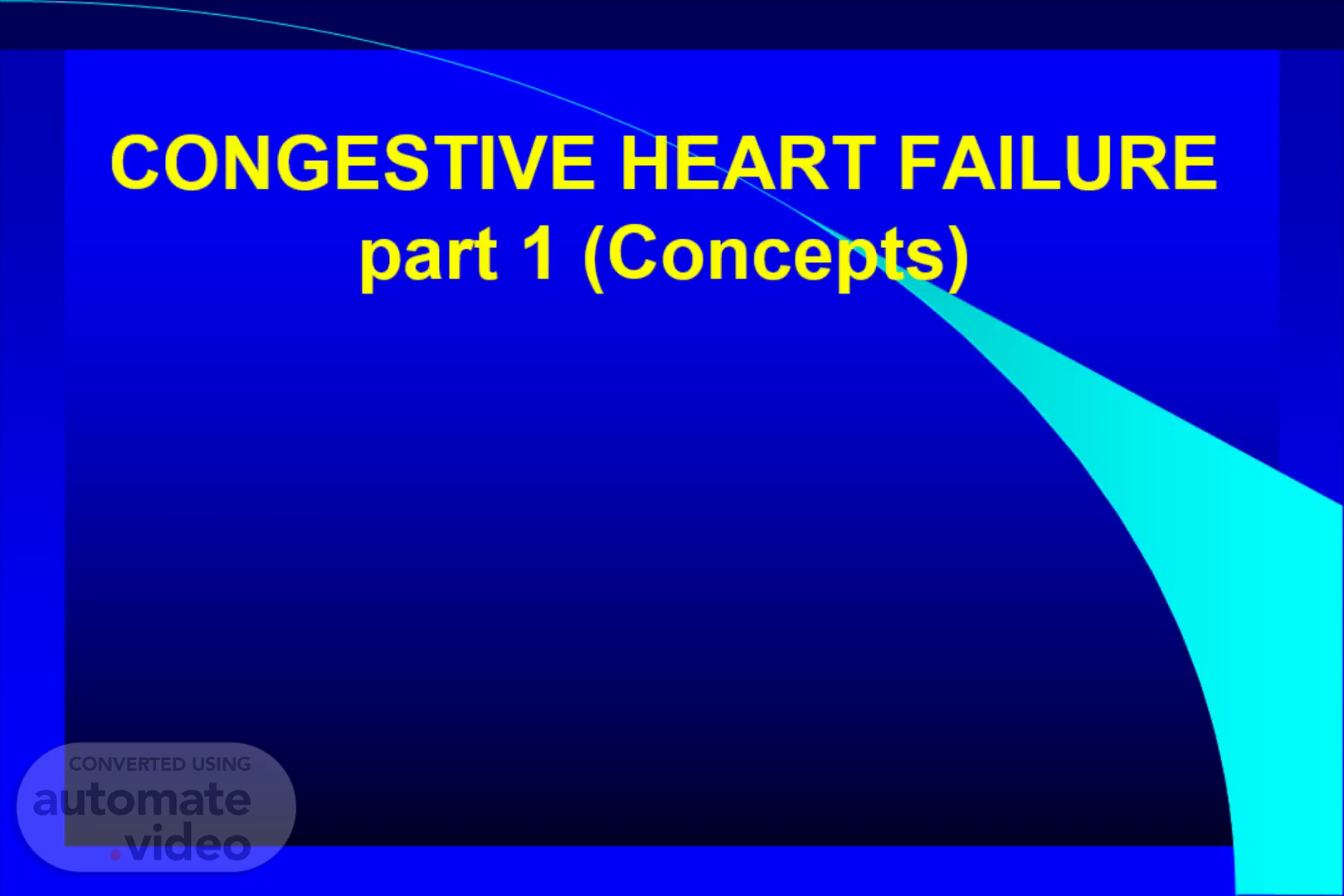
CONGESTIVE HEART FAILURE part 1 (Concepts)
Scene 1 (0s)
CONGESTIVE HEART FAILURE part 1 (Concepts). Prof Johan Schoeman BVSc MMedVet(Med) PhD Royal College Diplomate in Small Animal Medicine (London) Diplomate European College of Veterinary Internal Medicine Department of Companion Animal Clinical Studies, Faculty of Veterinary Science, Onderstepoort.
Scene 2 (14s)
Congestive heart failure. The retention of fluid in tissues or body cavities (backward failure) Decreased perfusion caused by progressive, deteriorating cardiac function (forward failure).
Scene 3 (32s)
Preload 1. The condition and pressure under which the ventricles fill . Too little preload (e.g. voluminous haemorrhage, so too little blood enters ventricles) is detrimental because cardiac output falls. Increasing preload is a good idea (e.g. as occurs naturally during exercise, when splenic contraction increases volume of blood arriving at the heart), but to a certain limit..
Scene 4 (1m 4s)
Preload 2. When more blood enters the ventricles, causing a mild distension, the ventricle will contract more strongly. This is the Frank-Starling law of the heart. Excessive preload can overstretch the ventricles, causing damage and a fall in contractility - as happens during patent ductus arteriosus, where too much blood enters the left atrium from the over-circulated lungs..
Scene 5 (1m 31s)
Preload. Lung blood volume. RV output. Systemic venous return.
Scene 6 (2m 48s)
Preload 3. Preload is dependent on systemic venous return (determined mainly by blood volume and venous tone) atrial contraction thoracic pressures pericardial pressures ventricular ejection fraction (i.e. amount of blood remaining within the ventricles after systolic contraction).
Scene 7 (3m 15s)
Afterload 1. The condition and pressure against which the ventricles must work . This is dependent on: the degree of systemic arterial and arteriolar vascular smooth muscle constriction or dilatation (i.e. downstream vascular resistance) obstruction to blood flow (e.g. pulmonic or subaortic stenosis) viscosity of blood (determined by PCV and total proteins)..
Scene 8 (4m 1s)
Afterload 2. Less afterload means less work for the heart, which is a good thing but to a point. Too little afterload can mean hypotension..
Scene 9 (4m 24s)
Myocardial failure. Loss of the normal function of the myocardial tissue either from cardiomyopathy, or as a process of end-stage myocardial “exhaustion” in chronic heart diseases of various types..
Scene 10 (4m 44s)
Left heart failure ?. Clinical signs caused by circulation problems originating from disease of: the aortic valve, left ventricle, mitral valve, or left atrium.
Scene 12 (5m 39s)
LA. LV. Mitral valve annulus. RV. Distended pulmonary veins.
Scene 13 (6m 9s)
Cranial lobar vein. Cranial lobar artery. Cranial lobar bronchus.
Scene 14 (6m 50s)
LV. Aorta. Aortic valve. Aortic Root. Coronary arteries.
Scene 15 (7m 31s)
Trachea elevated due to cardiomegaly. LA. LV. Right lateral thoracic radiograph.
Scene 16 (7m 50s)
PULMONARY OEDEMA patchy distribution in cats. Aerophagia.
Scene 17 (8m 14s)
Cat: left heart backward failure: severe pulmonary oedema – note the dilated pupils due to sympathetic nerve activation.
Scene 18 (8m 34s)
Right heart failure. Clinical signs caused by circulation problems originating from disease of the pulmonary arteries, pulmonic valve, right ventricle, tricuspid valve, or right atrium.
Scene 20 (9m 26s)
RV. PA. Pulmonic Valve. Left and right main pulmonary arteries.
Scene 21 (10m 10s)
Narrowed RV outflow track. Post-stenotic bulge in the pulmonary artery.
Scene 22 (10m 42s)
Cardiac silhouette not clearly visible due to pleural effusion.
Scene 23 (11m 6s)
Globoid cardiac silhouette due to pericardial effusion.
Scene 24 (11m 24s)
Pericardial effusion - Anechoic fluid surrounding the heart.
Scene 25 (11m 56s)
Ascites – actually rare in cats.
Scene 26 (12m 15s)
Severe ascites main manifestation of Right Heart Failure in dogs.
Scene 27 (12m 23s)
Right heart failure - Jugular distention.
Scene 28 (12m 43s)
Forward failure. Clinical signs caused by inadequate cardiac function, resulting in organ underperfusion . Classic manifestation of forward failure: syncope ( underperfusion of the brain). Syncope is a sign of forward, left-sided heart failure.
Scene 29 (13m 6s)
Backward failure 1. Clinical signs caused by the heart’s inability to accept the blood returning to it from the venous system. This is a failure of the heart to “keep up” with the amount of blood presented to it for re-recirculation. The result is an increase in the pressure of venous blood returning to the heart LHF – increased pressure in the pulmonary veins RHF – increased pressure in the cranial- and caudal vena cava and the pleural and coronary veins.
Scene 30 (13m 42s)
Backward failure 2. If this pressure increases excessively, the fluid part of blood (plasma) seeps through the blood vessel wall, causing third-space accumulation of fluid, namely effusions and oedema. A classic example of left-sided, backward heart failure is pulmonary oedema , The typical signs of right-sided, backward failure are hepatomegaly, ascites, pleural effusion, pericardial effusion, and jugular venous distension ..
Scene 31 (14m 11s)
Systolic dysfunction ?. Poor contractility/inotropy of the ventricles. Example: dilated cardiomyopathy..
Scene 32 (14m 27s)
Dilated cardiomyopathy. 5C.v.e•. LV. LA. RV. RA. LV.
Scene 33 (15m 11s)
Cardiac contractility/inotropy. Influenced by: Sympathetic nerve stimulation Drugs Metabolic factors Glucose Myocardial depressant factor Acidosis Anaemia Hypoxia.
Scene 34 (15m 40s)
Diastolic dysfunction. Poor ability of the ventricles to distend/relax and accept incoming blood into their chambers. (poor lusitrophy ) hypertrophic cardiomyopathy, constrictive pericarditis pericardial effusion.
Scene 35 (16m 7s)
LVW IVS LVW. Long axis cuts through the heart - Heterogenous manifestations of HCM in cats A: septum mainly thick at the base B: septum mainly thickened towards the apex.
Scene 36 (16m 35s)
Cardiac chronotropy. This is the speed of contraction/heart rate Influenced by: Sympathetic nerve stimulation Drugs Adrenaline Atropine Metabolic factors Glucose Myocardial depressant factor Acidosis Anaemia Hypoxia.